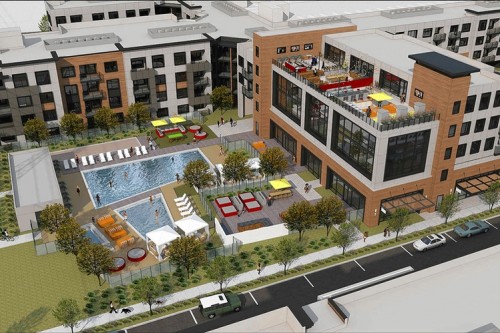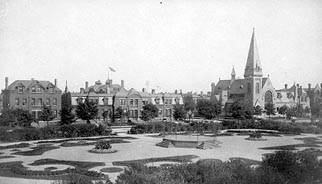
Silicon is a cyborg element. You can find it everywhere, but almost always bonded to something else. Silicon is the second-most abundant element on the planet and yet you have probably never seen it in its pure form. (For the record, it looks kind of like a leftover baked potato wrapped hastily in tin foil.) Entire geographic formations are named after the element, but (and I think this might be a first for naming conventions) those places have largely nothing to do with the extraction or even refinement of that element. Silicon is a prerequisite, a synecdoche for a larger industry that demands we refine and purify this promiscuous metal into a predictable and highly controlled component. True to its namesake, Silicon Valley (not to mention Austin’s lesser-known “Silicon Hills”) is an exercise in refinement. Intricate and eclectic streets are tossed aside in favor of gleaming, modern campuses with strict access control. It is a place where functions are separated so that they may reach the sorts of optimal efficiencies that Le Corbusier promised and Moses tried to deliver. But unlike Moses or Le Corbusier, the planners and corporate patrons of Silicon Valley are making places meant to be freely chosen.
Despite the language of “synergy” and “disruption”, most Silicon Valley corporate headquarters are akin to the Jeffersonian university campus: secluded, quiet, and contemplative. A place where the outside world is intentionally buffered away so that those inside the campus could make big gambles in science and politics. In 1820 Jefferson described his soon-to-be university as an institution that “will be based on the illimitable freedom of the human mind. For here we are not afraid to follow truth wherever it may lead, nor to tolerate any error so long as reason is left free to combat it. In order to make the sorts of breakthroughs that would (for example) “put a dent in the universe” you needed to be locked away with your fellow dudes studying the liberal arts and sciences.
Whereas the University of Virginia was meant to breed people that would go off to make useful things, the campuses of Silicon Valley are meant to write the patents and design the products. They are not only a place of contemplation and examination; they are also centers of (post)industry. Silicon Valley might have started life as a series of campuses, but it may very well become something very different in the next couple of years. Google has been operating a private bus system since 2007 and the Wall Street Journal is now reporting that Facebook plans to build a 397-unit housing complex called Anton Menlo for its workers right next to its Menlo Park campus.
It should be noted that the etymology of campus has more to do with the space between buildings than the buildings themselves. The Latin root words refer to fields, pastures, and common spaces. To build a campus is to be concerned with the ordered and planned interactions between components of a finite set. A campus works (in theory) because every part is custom-fitted to the other. A company town is different. A company town is an exercise in monopoly economics. An offer you cannot refuse. You live there as a stipulation of your employment contract and your employer uses the contract as an opportunity to shape you into the perfect worker. 21st Century Anton Menlo however is not a 19th Century company town like Pullman, Illinois. It differs in a few very important ways. First I want to describe a few key components of the industrial company town before discussing what I think is important and new about Anton Menlo.
When new factories would open, and word spread of a reliable employment opportunity, workers would set up informal settlements on the outskirts of the city. Much like the favelas of Rio de Janeiro today, these towns were self-organized hotbeds for political populism but lacked basic resources or safety. They caught fire and were constantly plagued with sanitary problems and concomitant diseases. Governments refused to extend services to these settlements, despite their lack of affordable housing.

When George Pullman built his new factory on the outskirts of Chicago, he decided to also build a planned town. It had shops, schools, churches, and libraries as well as housing for 6,000 employees and their families.Homes were outfitted with the most modern amenities: steam radiators, modern sewage and water hookups, natural gas fixtures for lighting and cooking and even a closed-loop waste recycling system that would fertilize crops to be sold back to workers at the company store. Pullman also aspired to make his skilled workers just as modern as the buildings they lived in. Almont Lindsey, in a 1939 issue of The American Historical Review, wrote:
“Desirous of avoiding labor difficulties, [George] Pullman believed that paternalism wisely administered would lull the restless yearnings of the laborer and give to his powerful corporation a stability in labor conditions not hitherto known” (P. 273, Volume 44, Number 2).
Homes were subject to regular inspection and counselors would instruct wives on proper home maintenance. For the first several years, Only Presbyterians were allowed to use the church without paying an exorbitant rental fee. Workers were required to live in the town, and once you were trained as a train car builder you didn’t have many other choices for employment except Pullman. The company continued to increase living costs and decrease wages until 1894 (about 14 years after the town was built) when a strike and subsequent boycott disrupted nationwide rail traffic. The worker-inflicted property damage and the state’s violent suppression of the strike was enough to tarnish the company’s reputation and cause the Illinois Supreme Court to order the dissolution of Pullman’s total ownership of the town. Company towns haven’t been very popular since.
The company town wasn’t meant to isolate you from society the way the campus did. Instead, it was meant to indoctrinate you into a particular kind of society. The campus is meant to free the individual from norms by providing physical isolation and the necessities of life; the company town imposes norms through the selective withholding and distribution of those same resources. Facebook’s burbclave doesn’t do either of these things. No one is required to live in the subdivision; in fact it’s only big enough to accommodate ten percent of Facebook’s current workforce and I suspect there is a good reason for the planned scarcity.
Facebook’s workers are likely to see themselves more as upper middle class entrepreneurs than toiling workers. They definitely have more material comforts than a factory worker, but it isn’t clear whether that translates into economic security. A single twenty-something working at a social media company might take home a low six-figure salary, but there will be student loan bills waiting for them. Even someone with a well paying job must still think about how they can make themselves indispensable. After awhile you might find yourself asking: Are you networking or hanging out with your friends? What’s the difference anymore”
The Wall Street Journal wonders if “the downside [of Anton Menlo] could be unspoken expectations that employees always be working.” That just seems quaint. The computer industry pioneered the constantly working employee over 30 years ago. David Byrne’s 1986 movie True Stories stated it quite bluntly when the mayor of a small Texas town triumphantly exclaims to his children over dinner, “Linda, Larry there’s no concept of weekends anymore!” He is thrilled to see that the microprocessor company that just setup shop has employed so many people that cannot tell when they are working or playing. Anton Menlo not only encourages the dissolution of the work/play divide, it capitalizes on it.
Instead of the compulsory residency of a company town, or the material necessity of on-campus dormitories, the subdivision solves the problems the corporation created in the first place. By dodging taxes and competing with local businesses with their own cafeterias and in-house services, Silicon Valley companies create unappealing and expensive housing markets without public transit. As Tom Foremski at the Silicon Valley Water observes: “Living in the shadow of the Googleplex, or Twitterplex, or Facebook’s giant campus at 1, Hacker Way, is causing job losses and hurting rather than boosting the local economy.”
If the corporate campus was Jeffersonian, and the industrial corporate town was Fordist, then the Silicon Valley corporate subdivision is Gramscian. You choose to live in a place owned by your employer, so as to gain access to the benefits only it can provide. You enter into a contract and accept Facebook’s increased presence in your life in exchange for very useful goods and services. They’ll walk your dog for you and organize three-legged races. You will have an affordable rental within walking distance of your workplace and all you have to give them is the promise of further investment in the Silicon Valley ideology of cyber-libertarianism. You will knowingly and willingly consent to this ideology not only because you get useful things (that are scarce because the company made them that way) but because it seems as though this ideology is the only thing that works. The company is its own theater of proof [paywalled PDF] that showcases the effectiveness of its own ideology. Your employer wouldn’t be able to afford a world-class sushi chef every Thursday if they weren’t doing something right. This is the ultimate melding of work and play- your play appears to you as the product of (not just the reward for) good work. You don’t just enjoy your job; you enjoy the world your job creates. Your work is like silicon: everywhere and yet never completely recognizable.
David is on Twitter and Tumblr.


Comments 5
robinjames — October 9, 2013
love love love this! Early in the article you use the term "breeding" to refer to the function of the Jeffersonian college campus. In part that's literal--colleges are literally about the breeding of the next generation of whatever constituency that campus serves. At Princeton, it's about the 1%, at Miami (where I went), it's about middle-class technocrats, and so on. Might these corporate campuses also have a literal breeding function?
Ownership of the Commons in an Age of Divestment » Cyborgology — October 18, 2013
[...] insidiously, as Silicon Valley’s penchant for corporate subdivisions and campuses can attest, these companies are part and parcel of the divestment in publicly held goods and [...]
In Their Words » Cyborgology — October 20, 2013
[…] “Anton Menlo not only encourages the dissolution of the work/play divide, it capitalizes on it” […]
The Network of Things to Come » Cyborgology — December 16, 2013
[…] campus life of the Silicon Valley brogrammer could be seen as a neoliberal fork of a thoroughly socialist project. Rockefeller Plaza was the […]